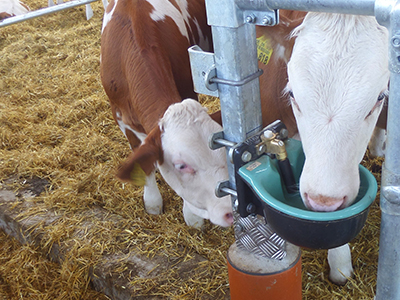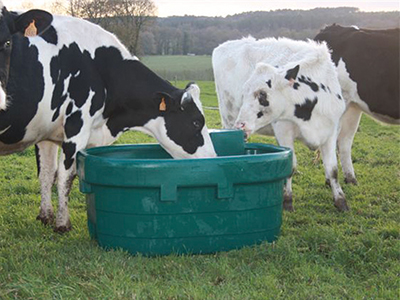It is well known: summer and winter, cows, or any other farm animal, must have access to fresh and clean water at all times. A cow contains between 56 and 81% water (Murphy, 1992) and this water represents 80% of the volume of blood. The slightest dehydration can be fatal for the animal. So, it is relevant to say that for a cow waterer, you need water in abundance.
WATER CONSUMPTION IS INFLUENCED BY VARIOUS FACTORS SUCH AS:
- Milk production
- Dry matter in the food ration
- Ambient temperature
- Stray voltage
- Soiled drinkers
To produce a liter of milk, a cow needs to drink about 4-5 liters of water. On average, the cow drinks from 5 to 8 liters per minute and can go up to 25 liters if she is very thirsty.
During periods of high heat or when she is lactating, she can increase her daily water consumption to 150 liters depending on her milk production. This is why care must be taken to optimize watering by installing a watering station, with a good flow of water, for many animals.
CLEAN AND FRESH WATER
Even today, we see farmers neglecting the importance of water when it should be a top priority. Would we, humans living in North America, agree to run out of water, not to drink to our fullest, to drink dirty and contaminated water? No. Well, it's the same for animals.
Ideally, livestock drinkers should be placed at a maximum distance of 49' (15 m) from each other. It is important that each animal in a herd can access at least two watering points. Hence the importance of having an efficient, reliable and durable watering system.
A WELL TOUGHT OUT LOCALIZATION STRATEGY
Placing your cow waterers in a free-stall farm to:
- Prevent the animal from moving a long distance
- Allowing more cows to drink at the same time
- Prevent cows from defecating in the trough
This will also guide you to choose which model to install. Example: at the exit of the milking parlour, the cows are always very thirsty (they drink 30% of their daily water consumption after milking). A high-volume trough-type with a water flow rate of up to 40 liters/minute is a logical choice.
Like SUEVIA's Quick Drainage Trough. Made of stainless steel, floor or wall installation, large water drain for quick cleaning. These are just a few advantages of a long list of quality.
In the ends of aisles, a cow trough that takes up little space like:
SUEVIA Valve Trough Drinker model 500 (one watering station, sufficient for 15-20 animals) or model 520 (two watering stations, sufficient for 30-40 animals). Water flow up to 30 liters/minute.
SUEVIA Float Valve Trough Drinker model 600 (one watering station, sufficient for 15-20 animals) or model 620 (two watering stations, sufficient for 30-40 animals). Water flow up to 40 liters/minute.
TIE STALLS
SUEVIA offers a variety of individual cow waterers (heated waterers or not) made of stainless steel, cast-iron or resistant plastic with a large flow of water.

PASTURE TROUGHS
SUEVIA's range of robust, UV-resistant polyethylene pasture waterers are made to withstand the elements. It is necessary to think about installing the drinking troughs near the grazing area so that the animals can come to drink regularly. And there must be enough to prevent cows that are further down in the hierarchy to drink as they please.

WHY A SUEVIA LIVESTOCK WATERER?
In fact, the design and engineering of SUEVIA waterers has proven their worth: for nearly 100 years, this state-of-the-art German manufacturer has been able to adapt to the realities of dairy farmers around the world by offering products with exceptional properties in terms of quality and reliability for all components, including floats and valves.
Everything is designed for the comfort, safety and ergonomics of the cow, but also to facilitate the work and offer peace of mind to the farmer.
At Agriclé, it is our pride to offer our customers products that last over time. That's why SUEVIA pet waterers are a safe bet when it comes to rejuvenating or building a farm.









